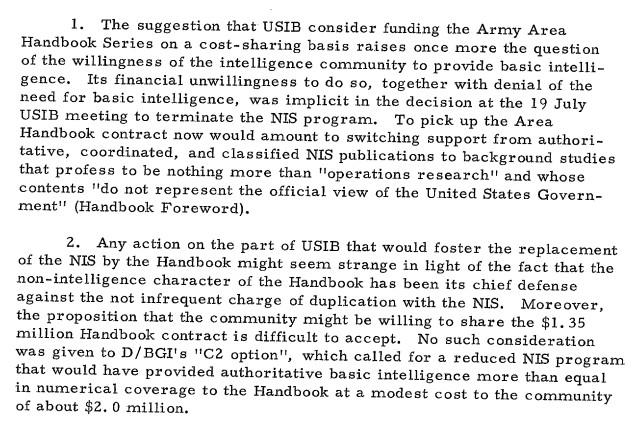During my dives into the CIA archive, in a few documents I saw a passing mention to “Army Area Handbooks”. At first, I thought they were related to the Intelligence Handbooks which I wrote about earlier, but Army Area Handbook history seems to be separate from them.
Until 2000s, the Federal Research Division of the Library of Congress maintained a series of publications called Area Handbooks. According to LoC, the original focus of the series of Country Studies was to cover select regions of the world where U.S. armed forces might be deployed. Prior to the Library of Congress, the handbooks were created by American University’s Foreign Area Studies Division.
A document in the CIA archive sheds some more light to the origin of the Area Handbooks. Before the Foreign Area Studies Division, the handbooks were created by Special Operations Research Office (SORO) also affiliated with the American University. SORO took over responsibility for the handbooks from Yale’s Human Relations Area Files (HRAF), which had created the first handbooks with Army G-3’s operations research funding. One of the drivers for the creation of the handbooks was the need for intelligence support to psychological warfare planning. HRAF had dropped their government research connections in the 1960s, mandating the move to SORO.
The Area Handbook series apparently had been a source of internal debates at the CIA, as the contents were seen as overlapping with that of the National Intelligence Survey‘s General Surveys. To quote a comparative assessment of the two from 1973:
Since the Handbooks are generalized background studies that emphasize sociological, political, economic,and military factors (most of the books have four secitions–Social, Political, Economic, and National Security), duplication or overlap with the NIS General Survey is unavoidable. Levels of detail and depth of analysis vary within the publications, but in general, the Handbook includes a fairly extensive historical background and sociological discussion. In fact, many OCI [CIA’s Office of Current Intelligence] analysts who formerly prepared [NIS] General Survey sections on the society drew heavily on the Handbooks in their research, since the latter were compiled from the same open sources that OCI was using. In other areas, the Handbooks are less authoritative. Their level of political analysis tends to be shallow, leaning heavily on constitutions and organizational manuals that state how things ought to be rather than how they actually function. Background information on geography slanted toward military operations, on the capacity of transportation systems, and on military capabilities suffers from the inability of the Handbook researchers to draw on classified sources and expertise. Given the Handbooks’ academic origin and the background of the researchers who produce them, the emphasis on and skill in describing cultural aspects is no more surprising than their tendency to follow the party line on government operations and political affairs.
A few other documents of interest can also be found from the CIA archive. A July 27, 1973 memo after the termination of the NIS program summarizes a discussion in USIB, after the Army had indicated they’d pull funding from the Area Handbook program. USIB was considering funding the Area Handbook program on a cost-sharing basis, which drew a pointed reply on August 10, 1973 from the Director of Basic and Geographic Intelligence. He noted the incongruence between terminating NIS and shortly afterward considering funding the Area Handbook. Quote from the document below:

Yet, the usefulness of the Area Handbooks was not disputed:
The argument does not imply that Area Handbooks are without merit. While their political and economic analysis tends to be shallow, relying heavily on the publications of the country concerned, and they make little attempt to assess national stability or military capabilities, their discussions of a country’s historical backgroundand culture are generally extensive and accurate.
Where to find them
The latest versions of the Area Handbooks can be found through the Library of Congress. There are a total of 80 studies on the site, which can be downloaded as PDFs.
Older versions of some of the studies can be found through one of my favorite resources, the Defense Technical Information Center, or DTIC. I’ve compiled the downloadable versions of the Area Handbooks in DTIC’s archive below. Most appear to be comparable to version in LoC’s archive.